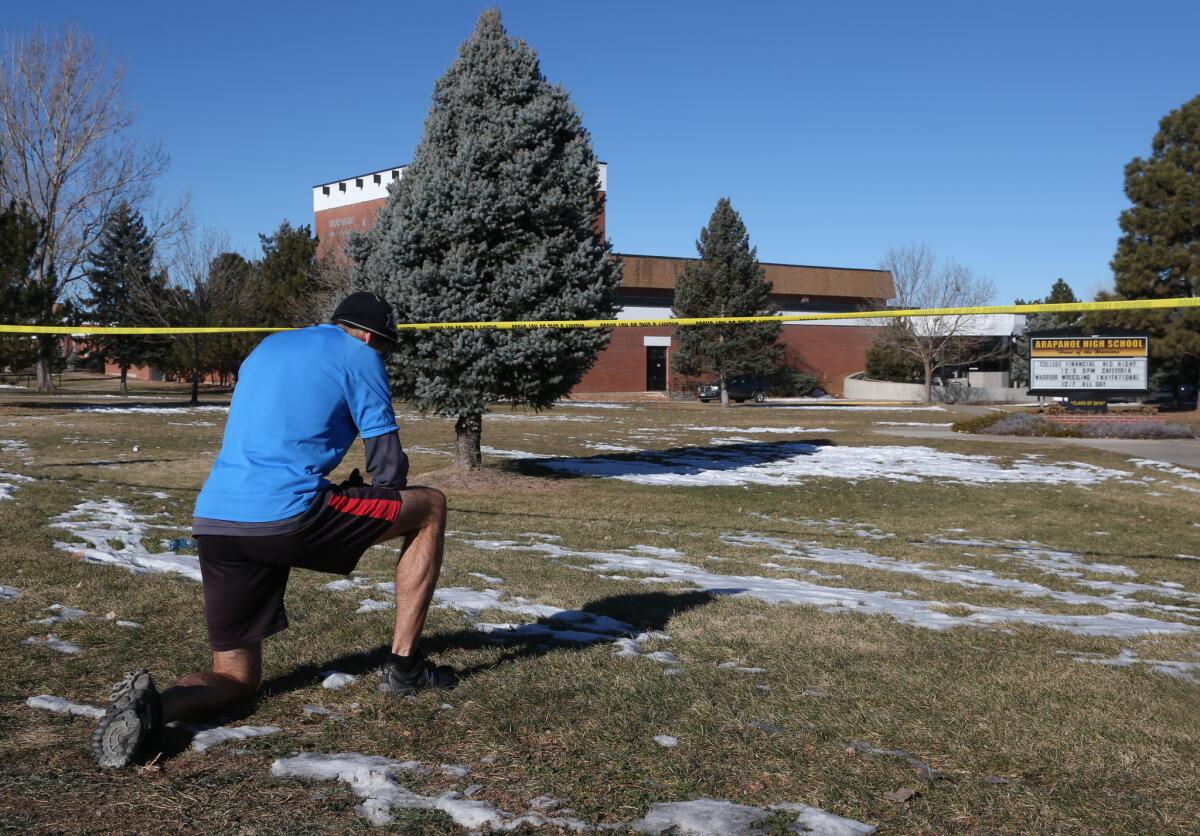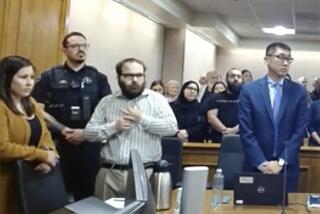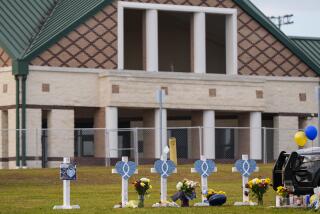Colorado school shooting: State again finds itself in gun debate

- Share via
As it struggles to deal with the latest deadly school shooting, Colorado finds itself in a familiar place, enmeshed in the ongoing debate over how to control gun violence.
On Saturday, police continued their investigation into the latest attack, the third in which troubled gunmen opened fire in crowded places with which the state has had to contend since 1999. Karl Halverson Pierson, 18, apparently frustrated by being removed from the Arapahoe High School debate team and angry at its coach, entered the school building in the Denver suburb of Centennial with a shotgun looking for the teacher.
When Pierson couldn’t find the educator on Friday afternoon, he opened fire, critically wounding one student and then killing himself.
As tragic as the attack was, the context adds to its distress. It came a day before the first anniversary of the assault on Sandy Hook Elementary School in Newtown, Conn., where another lone gunman killed 20 children and six adults before committing suicide. That attack renewed the fight over gun-control legislation which led to Colorado passing three tough measures; those laws, in turn, sparked a political backlash that cost three lawmakers their posts.
Recent times have been hard for Centennial. Residents have already coped with deadly floods and fires, so the area is no stranger to tragedies and catastrophes, including those involving guns.
Arapahoe High couldn’t be located better -- or, worse -- for the gun-control debate. With some 2,100 students, it is about eight miles east of Columbine High School, where two students killed 12 students and one teacher in 1999. The school is about 15 miles southwest of the Aurora movie theater where a gunman shot 70 people, killing 12, in July 2012.
After Newtown, President Obama signed 23 executive orders designed to limit gun violence, but the centerpiece of his proposals languished in Congress, essentially making any action on gun control a matter for the states.
Colorado was joined by Connecticut, Maryland, New York and Delaware in requiring background checks for all gun purchases in person or online, including at gun shows. Connecticut, Maryland and Colorado also banned certain types of high-capacity magazine or “assault” rifles. In all, about 1,500 gun bills were introduced in state legislatures.
But of the 109 bills that became law, nearly two-thirds loosened gun restrictions, according to a New York Times analysis.
Colorado was the first state in the West to pass tougher laws and the battle between supporters and their opponents was fierce. Located in the former frontier but changing West, the state has always been a battleground between those committed to keeping guns available and those seeking to control them.
Led by Democrats, Colorado passed some of the nation’s toughest gun legislation this year, including an expansion of background checks for gun buyers and a limit on the size of ammunition magazines. Democrats were riding a wave of popular support for some action after the Connecticut slayings.
Hunters and others organized a boycott of Colorado to protest the limits on guns. Groups including Rocky Mountain Gun Owners and the National Rifle Assn. organized the successful recalls in September of two Democratic state senator -- Senate President John Morse and Sen. Angela Giron -- who voted for the tougher laws.
Gun control groups spent $4 million to unsuccessfully defend the senators, including a $350,000 donation from outgoing New York City Mayor Michael R. Bloomberg, according to records from Sunlight Foundation, which monitors campaign financing. Pro-gun groups poured $606,000 into the race. Two-thirds of that money could be traced back to the NRA, the Sunlight Foundation said.
To keep the state Senate in Democratic hands, state Sen. Evie Hudak, a Democrat from the Denver suburb of Westminster who voted for the gun-control laws, resigned her seat in late November rather than fight a recall effort. Under Colorado law, whoever is appointed to fill Hudak’s seat must be a Democrat.
“This historic event should put every gun-grabber in the Capitol on notice for the 2014 elections,” said Dudley Brown, executive director of Rocky Mountain Gun Owners, in a statement following Hudak’s resignation.
If Colorado was among the trendsetters in passing tougher legislation and in dealing with the political fallout, its history has also forced it to take the lead in the tragic necessity of preparing for the worst. Many students interviewed by the Los Angeles Times talked about how they had relied on their training in the crucial first moments of the attack on Friday.
They sought shelter in locked classrooms and in small spaces until they could be escorted out of the building with their arms raised to show that no gunman was among those fleeing. Sheriff Grayson Robinson praised the teacher who had been targeted by Pierson for leaving the building, thus eliminating a target for the gun-wielding student. The teacher’s departure also served to bring some students out of the possible line of fire, Robinson said.
Whitney Riley, a 15-year-old freshman, said everyone started running when they heard shots. She finally ended up with eight other people, including two teachers, crammed into a tiny sprinkler system room. In those moments, she said, she remembered all of the drills she had gone through.
“People were running through the halls, yelling, ‘Get out, get out,’” she said. But those in the sprinkler room did as they were trained and refused to open the door because they did not know whether it might be the shooter seeking more victims.
Finally, one of the teachers said, “Let’s go while we can.”
ALSO:
Amid hatred, Colorado shooter mourned
Colorado shooter said to have been targeting debate coach
Bells toll as nation marks anniversary of Sandy Hook school shooting
More to Read
Sign up for Essential California
The most important California stories and recommendations in your inbox every morning.
You may occasionally receive promotional content from the Los Angeles Times.











